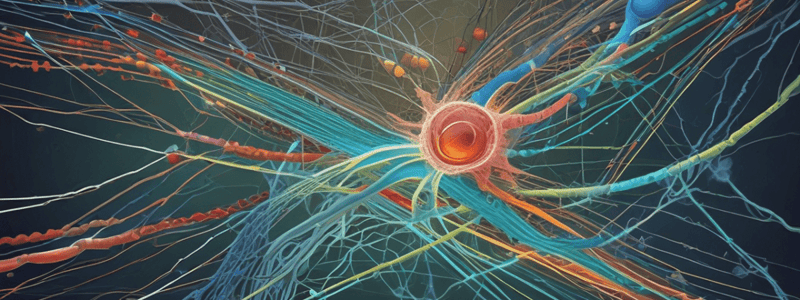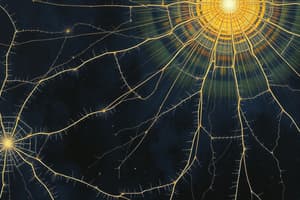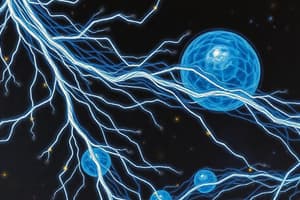Podcast
Questions and Answers
Which mitochondrial membrane contains mitochondrial porins and receptors for proteins and polypeptides translocating into the intermembrane space?
Which mitochondrial membrane contains mitochondrial porins and receptors for proteins and polypeptides translocating into the intermembrane space?
- Mitochondrial matrix membrane
- Outer mitochondrial membrane (correct)
- Mitochondrial cristae membrane
- Inner mitochondrial membrane
Where are the proteins contained in the membrane of peroxisomes synthesized?
Where are the proteins contained in the membrane of peroxisomes synthesized?
- On the rough endoplasmic reticulum (correct)
- In the peroxisomal lumen
- On the smooth endoplasmic reticulum
- In the cytosol
What is the function of peroxisomes in the cell?
What is the function of peroxisomes in the cell?
- Cell signaling
- Glycogen synthesis
- Protein synthesis
- Fatty acid oxidation and ROS detoxification (correct)
Which cell organelle universally contains catalase?
Which cell organelle universally contains catalase?
What is the underlying cause of the various metabolic disorders associated with peroxisomes?
What is the underlying cause of the various metabolic disorders associated with peroxisomes?
What is the role of microtubules in the cell?
What is the role of microtubules in the cell?
What is the function of the microtubule-organizing center (MTOC) in the cell?
What is the function of the microtubule-organizing center (MTOC) in the cell?
What is the characteristic of intermediate filaments in the cytoskeleton?
What is the characteristic of intermediate filaments in the cytoskeleton?
Which cytoskeletal component is associated with kinesin?
Which cytoskeletal component is associated with kinesin?
What is the function of the terminal web in epithelial cells?
What is the function of the terminal web in epithelial cells?
What is the structure of actin microfilaments in the cytoskeleton?
What is the structure of actin microfilaments in the cytoskeleton?
What is the primary function of the G1 DNA-damage checkpoint?
What is the primary function of the G1 DNA-damage checkpoint?
What is the function of the Microtubule Organizing Center (MTOC)?
What is the function of the Microtubule Organizing Center (MTOC)?
What is the main result of the malfunction of the spindle-assembly checkpoint?
What is the main result of the malfunction of the spindle-assembly checkpoint?
What is the function of the unreplicated-DNA checkpoint?
What is the function of the unreplicated-DNA checkpoint?
What is the term for the rapid depolymerization of microtubules?
What is the term for the rapid depolymerization of microtubules?
What is the function of γ-tubulin rings within the MTOC?
What is the function of γ-tubulin rings within the MTOC?
What is the main characteristic of G0 cells?
What is the main characteristic of G0 cells?
What is the location of the enzymes for β-oxidation of fatty acids?
What is the location of the enzymes for β-oxidation of fatty acids?
What type of nucleic acids are found in mitochondria?
What type of nucleic acids are found in mitochondria?
What is the result of a low level of oxidative phosphorylation in mitochondria?
What is the result of a low level of oxidative phosphorylation in mitochondria?
What happens to the mitochondrial transmembrane potential when the integrity of the mitochondrion is breached?
What happens to the mitochondrial transmembrane potential when the integrity of the mitochondrion is breached?
What is the function of cytochrome c and SMAC/DIABLO in apoptosis?
What is the function of cytochrome c and SMAC/DIABLO in apoptosis?
What is the role of caspases in apoptosis?
What is the role of caspases in apoptosis?
What triggers apoptosis?
What triggers apoptosis?
What is the role of the BCL-2 family proteins in apoptosis?
What is the role of the BCL-2 family proteins in apoptosis?
What happens to the electron-transport chain when the integrity of the mitochondrion is breached?
What happens to the electron-transport chain when the integrity of the mitochondrion is breached?
What is released from the mitochondrial intermembrane space when the integrity of the mitochondrion is breached?
What is released from the mitochondrial intermembrane space when the integrity of the mitochondrion is breached?
What is the result of the release of cytochrome c and SMAC/DIABLO from the mitochondrial intermembrane space?
What is the result of the release of cytochrome c and SMAC/DIABLO from the mitochondrial intermembrane space?
What is the function of caspases in cellular proteins?
What is the function of caspases in cellular proteins?
Flashcards are hidden until you start studying
Study Notes
Microtubules and Cytoskeleton
- Microtubules are attached to chromosomes at the apical part of an epithelial cell.
- The minus/plus ends of microtubules and actin microfilaments refer to the direction of their growth and shrinkage.
- Microtubule catastrophe occurs when a microtubule undergoes rapid depolymerization, leading to its disassembly.
- Proteins that limit the polymerization of actin microfilaments include actin-binding proteins.
- Proteins that limit microtubule polymerization in the Microtubule Organizing Center (MTOC) include γ-tubulin rings.
- The MTOC is a region near the centrioles where microtubules are organized and nucleated.
- The MTOC works by nucleating and organizing microtubules, which then grow and shrink to form the spindle fibers.
- The structure of the MTOC consists of γ-tubulin rings and other proteins that nucleate and organize microtubules.
- Intermediate filaments have no polarity, unlike microtubules and actin microfilaments.
- Kinesin is associated with microtubules.
Mitochondria
- The mitochondrial membrane that contains mitochondrial porins and receptors for proteins and polypeptides translocating into the intermembrane space is the outer mitochondrial membrane.
- The condensed morphology of mitochondria appears in the presence of high ADP concentrations, while the orthodox configuration occurs at low ADP concentrations.
- The functions of mitochondria include energy production through ATP synthesis.
- The underlying cause of various metabolic disorders associated with peroxisomes is a deficiency in peroxisomal biogenesis or function.
Peroxisomes
- Peroxisomes are organelles that contain catalase and are involved in various cellular functions, including fatty acid oxidation.
- The proteins contained in the membrane of peroxisomes are synthesized in the endoplasmic reticulum.
- The proteins contained in the lumen of peroxisomes are synthesized in the cytosol.
- The functions of peroxisomes include fatty acid oxidation, amino acid metabolism, and ROS detoxification.
- Forms of peroxisome biogenesis exist in the cell, including de novo synthesis and inheritance from parent cells.
Cell Cycle
- The G1 DNA-damage checkpoint allows the cell to repair DNA damage before entering the S phase.
- The restriction checkpoint allows the cell to pause and respond to DNA damage before entering the S phase.
- The functions of the cell cycle include DNA replication, cell growth, and cell division.
- The principal phases of the cell cycle include the G1, S, G2, and M phases.
- The G1 phase is the first growth phase, where the cell prepares for DNA replication.
- The S phase is the DNA synthesis phase, where the cell replicates its DNA.
- The G2 phase is the second growth phase, where the cell prepares for cell division.
- The M phase is the mitosis phase, where the cell divides into two daughter cells.
- Checkpoints exist throughout the cell cycle, including the G1, S, G2, and M phases.
- The spindle-assembly checkpoint ensures proper spindle formation before the M phase.
- The chromosome-segregation checkpoint ensures proper chromosome segregation during the M phase.
- Aneuploid cells are cells that have an abnormal number of chromosomes.
- Mitotic catastrophe occurs when a cell undergoes aberrant mitosis, leading to cell death.
Apoptosis
- The main result of the malfunction of checkpoints is the loss of control over cell growth and division, leading to tumorigenesis.
- G0 cells are quiescent cells that are not actively growing or dividing.
- The response to injury is fulfilled by a reserve population of stem cells represented by G0 cells.
- The loss of contact inhibition is a characteristic of cancer cells.
- Mitochondria play a critical role in apoptosis, where the release of cytochrome c and other proteins triggers a cascade of proteolytic enzymes.
- The irreversible release of intermembrane space proteins causes subsequent caspase activation and apoptosis.
- The BCL-2 family proteins regulate mitochondrial outer membrane permeability and dictate the interactions between anti-apoptotic and pro-apoptotic proteins.
Studying That Suits You
Use AI to generate personalized quizzes and flashcards to suit your learning preferences.




